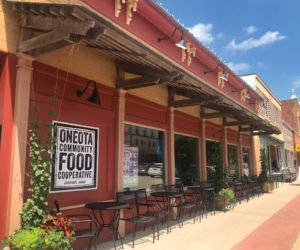By: Lyle Otte, Winneshiek County Protectors
Lyle Otte, Winneshiek County Protectors – May 5, 2015
The Winneshiek County supervisors contracted with the University of Iowa’s “Iowa Initiative for Sustainable Communities” to study the possible development of frac sand mining in Winneshiek County during the academic year 2014-15. A report was given in December of the first semester’s projects. The May 5th report covers the second semester’s studies. For a complete report of the studies, please go to http://urban.uiowa.edu/iowa-initiative-for-sustainable-communities (available in June).
The first report answered the question, where is the frac sand in the county? Using electronic information and actual samples from the county, the conclusion was that it is nearest (50’ or less) the surface in the 6 townships (Hesper, Highland, Canoe, Pleasant, Decorah and Glenwood) of northeast Winneshiek County. For the other study projects, the report focused on the Big Canoe Road area on the border with Allamakee County. The other projects then used that place as a hypothetical starting point.
The next report answered the question, is the frac sand (the St. Peter Sandstone formation) in the county useable for hydrofracking wells around the world? Using 3 physical and chemical tests, the author concluded that yes, the sand here can be used as part of the fracking process. The size, shape and hardness make it suitable.
A group of graduate students worked on the question, what would the economic impact of frac sand mining be for the county? In their first semester study, they focused on the positive effects and concluded that potentially, 15 to 60 jobs could be created depending on the number of mines and an estimated 1.5 to 16 million dollars could be generated throughout the local economy. This semester, the students focused on the negative effects and found that the damage to the hard surface roads from the heavy trucks would cost the tax payers between $650,000 and $3,000,000 to fix the damage. In addition, they studied the effect on property values to owners near a frac sand mine. Using Wisconsin’s experience, they concluded that a loss of about $3.5million would take place. That loss would also result in a loss of about $10,000 in property tax revenue. Water quality was also examined and they referred to a report of Wisconsin’s experience in 2014 in which storm water runoff led to 20 citations of the mining companies by the state DNR. Sediment and chemical pollution was reported. Impact of mining run off on ground water in our county due to the karst topography was also a concern. Tourism, especially trout fishing, in our county could also be affected negatively from the pollution possibility. Air quality in the county, both at the mine site and the transportation route could be affected by silica dust from the sand and diesel exhaust from the trucks. The students said more studies are needed to come to a clearer conclusion about the overall economic impact of frac sand mining in the county.
The students did recommend a set-back of over half a mile from trout streams for any mine here. They also urged limiting mines to 40 acres, locating mines away from visual sight lines of tourist areas and charging road use impact fees to the mining companies.
The director, Nick Benson, announced that the Institute for Sustainable Communities will again partner with Winneshiek County in school year 2015-16 to continue the study of frac sand mining and other topics.



